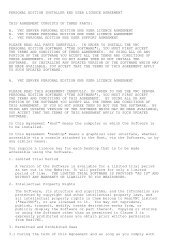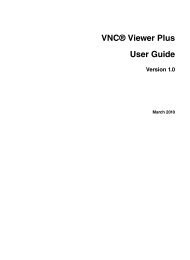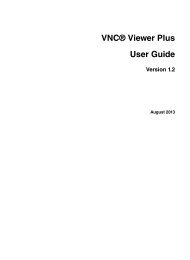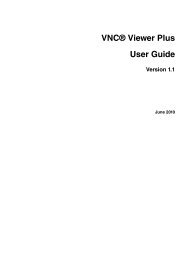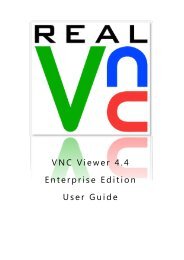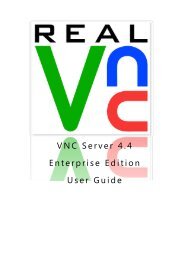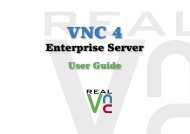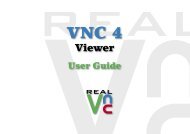VNC User Guide - RealVNC
VNC User Guide - RealVNC
VNC User Guide - RealVNC
Create successful ePaper yourself
Turn your PDF publications into a flip-book with our unique Google optimized e-Paper software.
Chapter 3: Using <strong>VNC</strong> Viewer<br />
Note that other <strong>VNC</strong> Viewer users may be connected to the host computer and controlling it at the same<br />
time as you. In addition, a host computer user may be present. Operations may occur unexpectedly!<br />
Controlling the host computer using your mouse<br />
Your client computer’s mouse is now shared with the host computer. This means that:<br />
• Moving the mouse and clicking within the <strong>VNC</strong> Viewer window affects the host computer and not the<br />
client.<br />
• Moving the mouse and clicking outside the <strong>VNC</strong> Viewer window, or on the <strong>VNC</strong> Viewer title bar or<br />
window buttons (Minimize, Maximize, and Close), affects the client computer and not the host.<br />
Note: If your mouse has no effect on the host computer, it may have been disabled. For more information,<br />
see Restricting access to features on page 46.<br />
If client and host computers have different numbers of mouse buttons, you can configure <strong>VNC</strong> Viewer to<br />
emulate those you do not have. See Configuring your mouse on page 45 for more information.<br />
Controlling the host computer using your keyboard<br />
Your client computer’s keyboard is now shared with the host computer, with the exception of:<br />
• The function key that opens the shortcut menu (F8 by default).<br />
• The CTRL-ALT-DELETE key combination.<br />
These commands are interpreted by the client computer. Alternative ways of sending them to the host<br />
computer are available; start with Using the shortcut menu on page 41 for more information. Under<br />
Windows, note you can choose for certain other keys or key combinations to be interpreted by your client<br />
computer rather than the host. See Configuring your keyboard on page 45 for more information.<br />
Note: If your keyboard has no effect on the host computer, it may have been disabled. For more information,<br />
see Restricting access to features on page 46.<br />
Note it is possible for client and host computers to have different types of keyboard. Not all the keys available<br />
to a host computer user may be available to you, and some keys with the same name may have different<br />
behavior. This is especially likely if you are connecting to Mac OS X from Windows or Linux with a PC<br />
keyboard, or vice versa; see www.realvnc.com/products/vnc/documentation/latest/misc/keyboard-mapping/.<br />
Interacting with <strong>VNC</strong> Server<br />
When you connect, a <strong>VNC</strong> Server icon<br />
is displayed on the host computer’s desktop, shaded black:<br />
(Windows 7 client computer; Ubuntu 11.10 Linux host)<br />
The <strong>VNC</strong> Server icon confirms that <strong>VNC</strong> Server is running on the host computer, provides information to<br />
help <strong>VNC</strong> Viewer users connect, confirms that at least one <strong>VNC</strong> Viewer user is connected (the icon changes<br />
color), and has a shortcut menu to perform useful operations. All this information and functionality is<br />
available to you as a connected user. For more information, see Working with <strong>VNC</strong> Server on page 81.<br />
<strong>VNC</strong> <strong>User</strong> <strong>Guide</strong> 39



